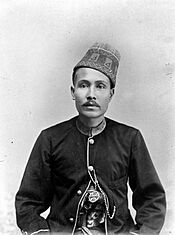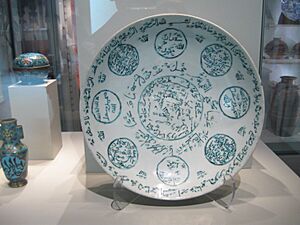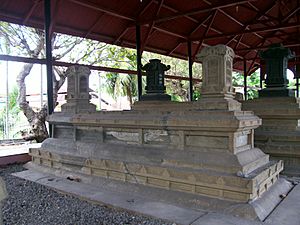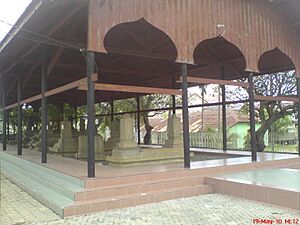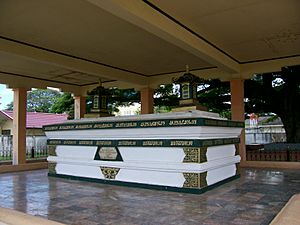Aceh Sultanate facts for kids
Quick facts for kids
Kingdom of Aceh Darussalam
Nanggroe Acèh Darussalam (Acehnese)
اچيه دارالسلام |
|||||||||||||||||||
|---|---|---|---|---|---|---|---|---|---|---|---|---|---|---|---|---|---|---|---|
| 1496–1903 | |||||||||||||||||||
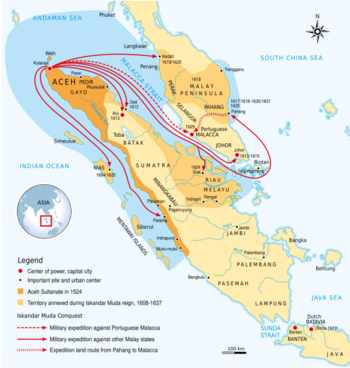
Map of the Aceh Sultanate in 1629
|
|||||||||||||||||||
| Status | Protectorate of the Ottoman Empire (1569–1903) | ||||||||||||||||||
| Capital | Kutaraja, Bandar Aceh Darussalam (modern Banda Aceh) | ||||||||||||||||||
| Common languages | Acehnese, Malay, Arabic | ||||||||||||||||||
| Religion | Sunni Islam | ||||||||||||||||||
| Demonym(s) | Acehnese | ||||||||||||||||||
| Government | Monarchy | ||||||||||||||||||
| Sultan | |||||||||||||||||||
|
• 1496–1530
|
Ali Mughayat Syah | ||||||||||||||||||
|
• 1875–1903
|
Muhammad Daud Syah | ||||||||||||||||||
| History | |||||||||||||||||||
|
• Coronation of the first Sultan
|
1496 | ||||||||||||||||||
|
• Aceh War
|
1903 | ||||||||||||||||||
| Currency | Native gold and silver coins | ||||||||||||||||||
|
|||||||||||||||||||
| Today part of | Indonesia Malaysia Singapore |
||||||||||||||||||
The Sultanate of Aceh was a powerful kingdom. It was located in what is now the Indonesian province of Aceh. This sultanate was a major power in Southeast Asia. It was especially strong during the 16th and 17th centuries. Its capital city was Kutaraja, which is now called Banda Aceh.
At its strongest, Aceh was a rival to the Johor Sultanate and Portugal's Malacca. All three wanted to control trade through the Strait of Malacca. They also wanted to control the trade of black pepper and tin. Aceh was known for its strong military. It was also an important center for Islamic learning and trade.
Contents
History
How Aceh Began and Grew
The Sultanate of Aceh was started by Ali Mughayat Syah. He began to expand his control in northern Sumatra around 1520. He took over areas like Deli, Pedir, and Pasai. His son, Alauddin al-Kahar, continued to expand the kingdom. He tried to gain control across the strait, but he was not as successful. He attacked Johor and Malacca several times. He even got help from the Ottoman Empire. The Ottomans sent ships and soldiers to help Aceh.
Aceh was located at the northern tip of Sumatra. This was a key spot for trade. Ships from the Bengal Sultanate would pass through. They carried diplomats to places like Ming China.
In 1599, a Dutch captain named Cornelis de Houtman arrived in Aceh. He was on one of the first European voyages to the East Indies. His crew stayed for three months. They bought pepper and other spices. Later, in 1602, James Lancaster arrived. He was from the English East India Company. He brought a letter from Queen Elizabeth I of England.
A powerful sultan named Iskandar Muda ruled from 1607 to 1636. He greatly expanded Aceh's control. He took over most of Sumatra. He also conquered Pahang, a region known for tin. He even made the sultans of Johor recognize his power for a while. During his rule, he created a set of laws called Adat Meukuta Alam. His strong navy was weakened in 1629. This happened during a battle against Malacca. Portuguese and Johor forces destroyed many of his ships.
After Iskandar Muda, his son-in-law, Iskandar Thani, became sultan. During his time, Aceh focused on making the kingdom stronger from within. It also worked on religious unity.
After Iskandar Thani, several female sultans ruled Aceh. During this time, Aceh's control over other areas weakened. Local rulers started to gain more power. The sultan's title became more symbolic. By the late 1600s, many local rulers were independent. Aceh then focused more on its own Acehnese identity.
Later Years and Dutch Conquest
In 1699, Sultan Badr al-alam Syarif Hasyim Jamal ad-din became ruler. He was the first male sultan in almost 60 years. After him, several rulers had short reigns. In 1727, a new family, the Buginese dynasty, took power. This further strengthened Aceh's unique identity. In the late 1700s, Aceh had good contacts with British traders. The sultan even allowed pepper plants to be gathered for cultivation in Penang.
In the 1820s, Aceh produced a lot of the world's pepper. A new leader, Tuanku Ibrahim, helped the sultanate regain some power. He managed to control the "pepper rajas" (local chiefs). He did this by playing them against each other. He later became sultan himself. He expanded Aceh's control to the south. This was happening as the Dutch were expanding their control north.
Britain had been protecting Aceh's independence. But they changed their policy. They signed a treaty with the Dutch in 1870-1871. This treaty allowed the Dutch to control all of Sumatra. In return, Britain got other benefits. This treaty basically meant war for Aceh. The Aceh War began soon after, in 1873. The Dutch claimed Aceh was supporting pirates. They also said Aceh was making a treaty with the United States. Sultan Alauddin Mahmud Syah II asked for international help. But no one was able to assist.
In early 1874, the sultan left the capital city. The Dutch captured the palace. The sultan went to the hills. The Dutch announced they had taken over Aceh. The sultan later died from cholera. But the Acehnese named his grandson as the new sultan. Local rulers pretended to submit to the Dutch. This was to avoid blockades. But they used their money to support the resistance.
Many Acehnese leaders sought help from the Ottoman Empire. Their efforts did not succeed. However, they inspired other resistance movements in Southeast Asia. The fight against the Dutch continued. Local lords and religious leaders took charge. One of the sultan's advisers, Abd al-Rahman al-Zahir, later surrendered to the Dutch. He received a pension to live in Mecca.
The Dutch faced many challenges, including disease. They built forts along the coast. They slowly began to take over the country. The capital was surrounded by forts and railways. The Dutch tried hard to control Aceh between 1898 and 1903. Each local ruler had to sign a "Short Declaration." This was a promise of loyalty to the Dutch. Because of this, the Dutch set up a stable government. The sultan surrendered in 1903. He was sent away in 1907. No new sultan was named. However, the resistance continued to fight until 1912.
Political Administration
During the rule of Iskandar Muda, the government became more centralized. This meant the sultan had more direct control. He replaced some old noble families with new ones. These new nobles were loyal to the state. The sultanate was divided into areas called mukim. Each mukim had a leader called an uleebalang. This leader was in charge of safety and order. Some pepper-producing regions were controlled by appointed governors. These governors reported on events and were rotated every three years.
Culture
Aceh saw itself as the successor to Pasai. Pasai was the first Islamic state in Southeast Asia. Aceh took over the role of spreading Islam after Malacca fell to the Portuguese. Aceh was called the "porch of Mecca". It became a major center for Islamic learning. The Qur'an and other Islamic books were translated into Malay there. Famous scholars from Aceh included Hamzah Fansuri and Nuruddin ar-Raniri.
Historians have also found that Acehnese writings were influenced by the Mughal dynasty. For example, the Hikayat Aceh (a historical text) has similar structures to Mughal historical works. This shows how ideas and stories traveled across different cultures.
Economy
Aceh became rich from exporting many goods. These included pepper, nutmeg, cloves, and betel nuts. It also exported tin after conquering Pahang in 1617. The sultanate had low interest rates. It also used gold currency. These things helped its economy. However, Aceh's economy was sometimes fragile. It was hard to produce enough extra food. This food was needed to support the military and trade. As Aceh's political power weakened in the 17th century, its trade importance also declined. The Dutch East India Company became the main power in the region. This happened after they successfully took Malacca in 1641.
Rulers
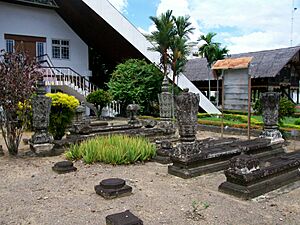
| Sultan of Aceh | Reign |
|---|---|
| Ali Mughayat Syah | c. 1514–1530 |
| Salahuddin | 1530–c. 1537/39 |
| Alauddin al-Kahar | c. 1537/39–1571 |
| Ali Ri'ayat Syah I | 1571–1579 |
| Sultan Muda | 1579 |
| Sri Alam | 1579 |
| Zainul Abidin | 1579 |
| Alauddin Mansur Syah | 1579–1585/86 |
| Ali Ri'ayat Syah II, Raja Buyung | 1585/86–1589 |
| Alauddin Ri'ayat Syah Sayyid al-Mukammal | 1589–1604 |
| Ali Ri'ayat Syah III | 1604–1607 |
| Iskandar Muda | 1607–1636 |
| Iskandar Thani | 1636–1641 |
| Ratu Safiatuddin Tajul Alam | 1641–1675 |
| Ratu Nurul Alam Naqiatuddin Syah | 1675–1678 |
| Ratu Inayat Zaqiatuddin Syah | 1678–1688 |
| Ratu Kamalat Syah | 1688–1699 |
| Badr ul-Alam Syarif Hasyim Jamaluddin | 1699–1702 |
| Perkasa Alam Syarif Lamtui Syah Johan Berdaulat | 1702–1703 |
| Jamal ul-Alam Badr ul-Munir | 1703–1726 |
| Jauhar ul-Alam | 1726 |
| Syamsul Alam | 1726–1727 |
| Alauddin Ahmad Syah | 1727–1735 |
| Alauddin Johan Syah | 1735–1760 |
| Alauddin Mahmud Syah I | 1760–1781 |
| Badr ul-Alam Syah | 1764–1765 |
| Sulaiman Syah | 1773 |
| Alauddin Muhammad Syah | 1781–1795 |
| Alauddin Jauhar ul-Alam Syah (first reign) | 1795–1815 |
| Syarif Saiful Alam Syah | 1815–1819 |
| Alauddin Jauhar ul-Alam Syah (second reign) | 1819–1823 |
| Alauddin Muhammad Da'ud Syah I | 1823–1838 |
| Alauddin Sulaiman Ali Iskandar Syah | 1838–1857 |
| Alauddin Ibrahim Mansur Syah | 1857–1870 |
| Alauddin Mahmud Syah II | 1870–1874 |
| Alauddin Muhammad Da'ud Syah II Johan Berdaulat | 1874–1903 |
See also
- History of Indonesia
- The spread of Islam in Indonesia
- Ottoman expedition to Aceh
- Islam in Indonesia





